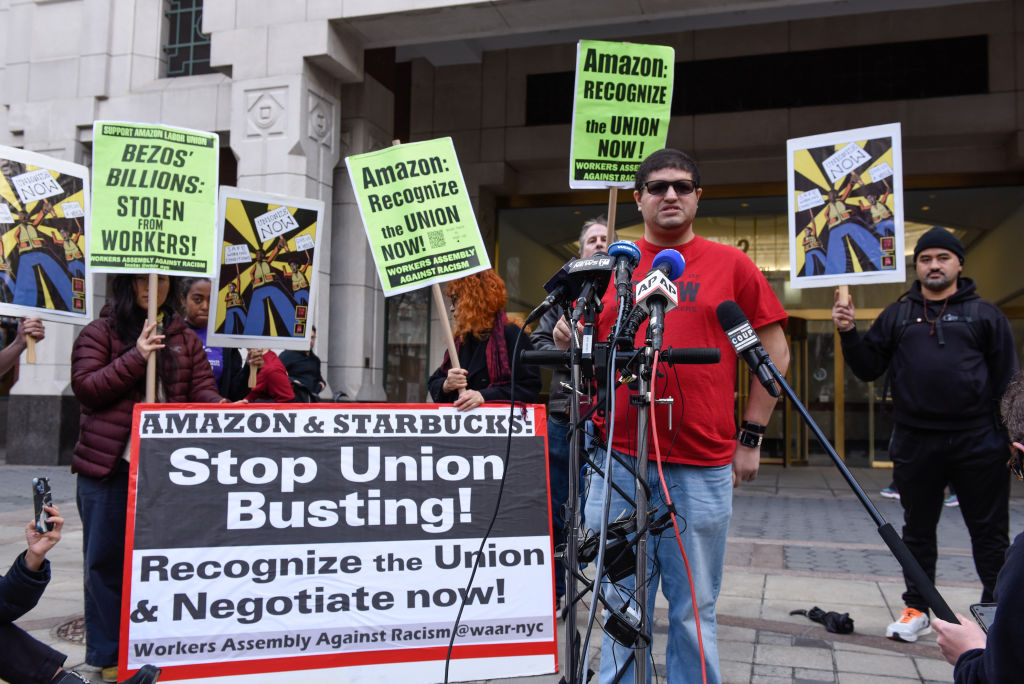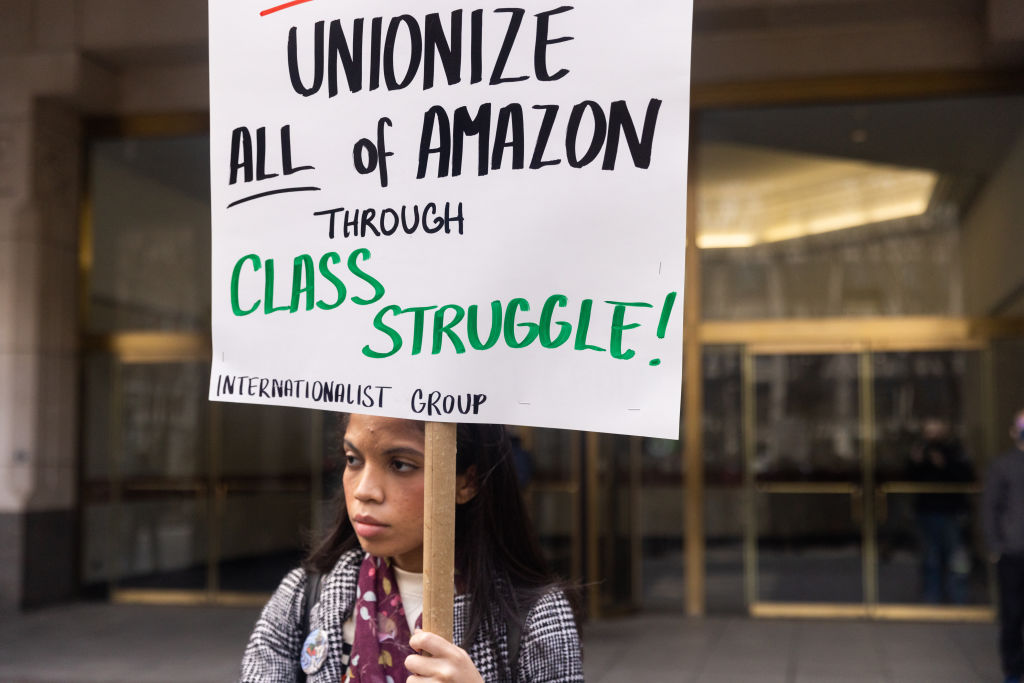
When Starbucks stores in upstate New York announced plans to unionize last December, labor historian Ileen Devault wasn’t sure if the U.S. was seeing the start of a trend or just a tiny blip in the history of workers’ activism in the country.
Now, as a wave of unionization has taken hold across shops and industries nationwide, Devault, a professor of labor history at Cornell University’s Industrial and Labor Relations School, knows it’s not just a blip. “It feels to me like a change in the air,” she says, and an indication of a meaningful shift in workers’ mindsets, even in the face of corporate antagonism. In 1970, union membership peaked at about 17 million nationally, over 30% of private-sector employees. By 2002, it had dropped by nearly half. Today, however, membership appears to be on the upswing.
The pendulum swings of unionization in the U.S. are part of a bigger picture: the neverending tension between businesses and workers. “Businesses and unions in the United States have pretty literally always had a very contentious relationship,” Devault says. “And it’s a relationship that’s much more contentious than the relationships between companies and unions in other countries. Historians have been trying to figure out for years why it is that it’s so much more problematic in the United States.”
As large corporations like Amazon sink millions of dollars into anti-union campaigns even as their workers rally successfully to unionize, that relationship looks poised to remain just as thorny. But when it comes to the reason that companies have dug their feet in against unions, the answer isn’t so hard-and-fast.
Why do companies fight unions?
Unions became popular in the U.S. starting in the 1930s, with membership rising from just over 10% of the eligible working population in 1936 to about a third by the mid-1950s, according to 2021 research published in the Quarterly Journal of Economics. That remained the case until the mid-1980s, when they fell out of favor, thanks to a culture in which companies refocused on maximizing shareholder value and minimizing worker benefits, as well as a court-backed emphasis on the value of private property and private profit. “Those years turned out to be basically a blip in what otherwise has been not only a very contentious, but many times a very violent interaction between workers and employers in this country,” Devault says of the mid-20th century.
During unions’ heyday in the U.S., however, the income gap between the richest and poorest Americans shrunk considerably. “The only time that the bottom tenth of the population and the top tenth of the population have come closer together has been during those years, when unions were operating in the largest corporations in this country,” Devault says. As unionization declined in the 1970s and 80s, that income gap grew once more. Today, it is at an all-time high since tracking began over 50 years ago, based on Census Bureau data. Research shows that as much as $50 trillion has migrated into the coffers of the top 1% of income earners in the U.S., an upward redistribution of wealth that has squeezed out the middle class.

Unions are responsible for bargaining contracts between workers and employers that guarantee anything from better working conditions to higher wages—on average union households have received 10-20% better pay than non-union households, according to one study. When benefits are considered, that improvement can rise to nearly 30%. And while that is certainly a boon for the workers themselves, corporations must adjust both their balance sheets and employment practices to acquiesce to the contracts. That’s at the heart of the battle between the two forces.
The distinctly American value of revering private property over public goods has made this relationship particularly challenging, says Devault. “We’re all supposed to try to gain as much private property as we can, and then protect it from anybody who isn’t us, whatever that means,” she says. “And I think that emphasis—and the fact that the courts have bought into that emphasis on private property—has meant that unions have always been seen as somehow against the whole idea of private property.” Instead of viewing unionization as a net positive that supports better returns for everyone contributing to a company, companies view their bottom line and profits as property that needs to be protected from workers.
Plus, unions give workers power that doesn’t always jive with the preferences of corporate leaders. “Unions aren’t just about higher wages. They are very much about workers having a say about what happens in the workplace,” Devault says. “And that’s what employers don’t like.” When things like vacation policies, health care benefits, and firing practices are set by the union and not the employer, it means the employer becomes more responsible for its workers—and less capable of, say, instituting layoffs.
How have companies been impacted by unionization?
While labor historians point to the positive impact that unions have had on decreasing income inequality and growing the middle class, economists point instead to the more complicated impact that unionized workforces can have on corporate profits. A 2009 NBER working paper suggested that “the average effect of a union win at a workplace is to decrease the market value of the affected business by at least $40,500 per worker eligible to vote, based on monthly stock prices… Calculations of the effects of a union victory suggest that it produces large negative returns of 10 to 14%.”
But these projections take into account stock value, which folds in the effects of public opinion, not just pure profit. “Organizing victories reduce growth in assets, because of decreased growth in plant, property, and equipment,” the study said, but “profit, and return on assets, appears unaffected by unionization.” In other words, organizing can slow down certain operations and growth plans, but bottom lines should be fundamentally unchanged.
Read more: U.S. Labor Unions Are Having a Moment
The true effect of unionization on business success is difficult to parse, further studies note, because unionization is “nonrandom” by nature. According to a comprehensive study from 2003 that reviewed nearly 30,000 firms in a nearly two-decade span, there are two main types of places where unions come together: some organize at “highly-profitable enterprises” that are very likely to survive collectivization, while others organize at firms that are “poorly managed, or… faced recent difficulties,” making unionization particularly appealing to workers. The conclusion, however, was clear: “Unions likely do not affect businesses by making them more susceptible to failure or re-location, despite the fears of many employers and employees.”
Plus, increased wages in union companies often means that wages rise across the board as standards change. When workers make more, they have more disposable income to spend more, and the broader economy is lifted. It’s the opposite of the trickle-down economics theory that became popularized in the 1980s.
Should workers be concerned about unionization?
There has long been rhetoric that unions do shift the employee-employer relationship—and may impact worker incentivization. When wages are standardized, good conditions are guaranteed, and layoffs are limited, workers have little motivation to work harder, companies argue.
But when unions are functioning well, Devault says, they aren’t just about pay—but about making sure that workers have more overall power in the workplace. “The pandemic has really changed the way people look at their work,” she says. “We’re starting to see now [that one of those changes is that] I want some say in what goes on in my workplace.” And when workers have more say, they can be more invested in their company’s future, too.
More Must-Reads from TIME
- Why Trump’s Message Worked on Latino Men
- What Trump’s Win Could Mean for Housing
- The 100 Must-Read Books of 2024
- Sleep Doctors Share the 1 Tip That’s Changed Their Lives
- Column: Let’s Bring Back Romance
- What It’s Like to Have Long COVID As a Kid
- FX’s Say Nothing Is the Must-Watch Political Thriller of 2024
- Merle Bombardieri Is Helping People Make the Baby Decision
Write to Raisa Bruner at raisa.bruner@time.com